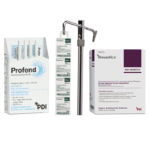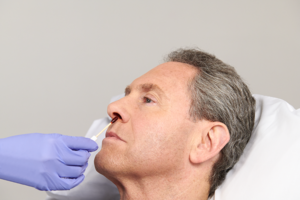Interventional Care


We notice that you are visiting us from . This site only services US-based visitors. Would you like to visit the site that is appropriate for your location?

Decolonization is an evidence-based patient safety practice with the goal of lowering the microbial bio-burden on patient body sites to reduce the risk of infection from endogenous colonization during surgery.
Nasal decolonization has become an important strategy for reducing surgical site infections (SSIs) due to Staphylococcus aureus (S. aureus). Data from the National Healthcare Safety Network (NHSN) for 2014 reports that S. aureus is the primary pathogen responsible for SSIs, with 42.6% of S. aureus SSIs caused by methicillin-resistant S. aureus (MRSA).1 The gold standard for nasal decolonization has been mupirocin; however, selective pressure has led to mupirocin-resistant strains of S. aureus and treatment failures. Patient compliance and satisfaction has been suboptimal, in part due to the need for multiple applications prior to surgery. As part of an overall approach to patient safety and antibiotic stewardship, investigators have looked to antiseptics, such as povidone-iodine (PVP-I), as alternatives.
An estimated 157,500 SSIs resulting in more than 8,000 deaths occur annually in the United States healthcare system.2,3 The estimated excess length of hospital stay (LOS) for these infections is 11 days, with a cost of $20,785. If MRSA is the causative pathogen, the LOS and cost increases to 23 days and $42,300, respectively.4 The anterior nares are the primary reservoir for S. aureus carriage and approximately 20-30% of healthy individuals are persistently colonized.5 Approximately 1-3% of healthy adults are colonized with MRSA; higher carriage rates have been reported among hospitalized and long-term care patients.6 As S. aureus carriers are two to nine times more likely than non-carriers to have SSIs7, perioperative nasal decolonization has been extensively studied as an SSI prevention strategy.
The introduction in the mid-1980s of mupirocin calcium ointment, with excellent in vitro activity against staphylococci and most streptococci, led to its widespread use as the decolonization agent of choice for preventing S. aureus infection and transmission. The orthopedic and cardiothoracic surgical communities have widely adopted mupirocin decolonization protocols. A systematic review of 19 studies of orthopedic surgery patients found a range of SSI reduction from 29%-57% in total SSIs for those using mupirocin alone, 13%-81% in total SSIs, 56%-200% reductions in S. aureus SSIs, and 29%-100% reductions in MRSA SSIs for those using mupirocin and chlorhexidine.8 A trial involving cardiac surgery patients with an intervention of pre-operative nasal screening for Methicillin-sensitive Staphylococcus aureus,(MSSA) and MRSA, decolonization of carriers with mupirocin twice daily and chlorhexidine daily bathing for 5 days, and modification of prophylactic antibiotics to vancomycin and cefazolin for MRSA carriers, found a 42% reduction in SSIs.9
However, in the late 1990s, mupirocin resistance began to emerge. Recent surveillance studies have reported mupirocin-resistant (MupR) MRSA strains in up to 13% of surgical ICU patients in the absence of routine use of mupirocin10 and 23.7% MupR among MRSA clinical isolates in a facility where mupirocin was routinely used to decolonize MRSA-positive patients.11 A strong association has been found between prior mupirocin use and subsequent mupirocin-resistant in MRSA.12 Currently, mupirocin susceptibility testing is infrequently performed, and the prevalence of MupR MRSA strains is unknown in many clinical settings. Concern has also been cited regarding suboptimal patient compliance with the mupirocin regimen of twice daily application for five days and overall patient satisfaction. These concerns have led to the use of antiseptics, such as PVP-I, as alternative nasal decolonization agents.
PVP-I is a complex of polyvinylpyrrolidine and tri-iodine ions which has been used widely for cutaneous antisepsis, has rapid bactericidal activity against both mupirocin-sensitive and mupirocin-resistant strains of S. aureus, and has no reports of bacterial resistance. In two recent studies, the impact on SSI after nasal decolonization with PVP-I was assessed.
The emergence of mupirocin-resistant S. aureus strains, suboptimal compliance and reduced patient satisfaction has led to the adoption of antiseptics for nasal decolonization. The most effective regimen for nasal decolonization to prevent SSIs should have proven efficacy against S. aureus, the major pathogen responsible for these infections, be easy to apply, have minimal adverse reactions, and be a positive experience for patients. PVP-I has rapid bactericidal activity against both mupirocin-sensitive and mupirocin-resistant strains of S. aureus, has no reports of bacterial resistance, can be applied immediately prior to surgery to suppress nasal carriage during the period of risk for bacterial contamination, has high patient satisfaction scores and is cost-effective. PVP-I offers a promising alternative to mupirocin for the prevention of SSIs.
1Weiner LM, Webb AK, Limbago B, et al. Antimicrobial-Resistant Pathogens Associated with Healthcare-Associated Infections: Summary of Data Reported to the National Healthcare Safety Network at the Centers for Disease Control and Prevention, 2011-2014. Infect Control Hosp Epidemiol 2016:1-14.
2Klevens RM, Edwards JR, Richards CL Jr, et al. Estimating healthcare-associated infections and deaths in US Hospitals, 2002. Public Health Rep 2007; 122: 160-166.
3Magill SS, Edwards JR, Bamberg W, et al. Multistate Point-Prevalence Survey of Healthcare-Associated Infections. N Engl J Med 2014: 370; 1198-1208.
4Zimlichman E, Henderson D, Tamir O, et al. Healthcare-Associated Infections: A Meta-Analysis of Costs and Financial Impact on the US Healthcare System. JAMA Intern Med 2013;173 (22):2039-2046.
5Boyce JM. Preventing Staphylococcal Infections by Eradicating Nasal Carriage of Staphylococcus aureus: Proceeding with Caution. Infect Control Hosp Epidemiol 1996;17(12):775-78.
6Septimus EJ and Schweizer ML. Decolonization in Prevention of Healthcare-Associated Infections. Clin Micro Reviews 2016;29(2):201-222.
7Wenzel RP, Perl TM. The significance of nasal carriage of Staphylococcus aureus and the incidence of postoperative wound infection. J Hosp Infect 1995; 31:13-24.
8Chen AF, Wessel CB, Rao N. Staphylococcus aureus Screening and Decolonization in Orthopaedic Surgery and Reduction of Surgical Site Infections. Clin Orthop Relat Res 2013 471:2383–2399.
9Saraswat, MK, Magruder JT, Crawford TC et al. Preoperative Staphylococcus aureus Screening and Targeted Decolonization in Cardiac Surgery. Annals of Thoracic Surgery 2017.
10JonesJC,RogersTJ,BrookmeyerP,et al. Mupirocin resistance in patients colonized with methicillin-resistantStaphylococcus aureusin a surgical intensive care unit.Clin Infect Dis2007;45:541–547.
11 Mongkolrattanothai K, Mankin P, Raju V, Gray B. Surveillance for Mupirocin Resistance Among Methicillin-Resistant Staphylococcus aureus Clinical Isolates. Infect Control Hosp Epidemiol 29:993-994.
12 Caffrey AR, Quilliam BJ, LaPlante KL. Risk factors associated with mupirocin resistance in methicillin-resistant Staphylococcus aureus. J Hosp Infect. Nov; 76(3):206–210.
13Phillips M, Rosenberg A, Shopsin B, et al. Preventing surgical site infections: a randomized, open-label trial of nasal mupirocin ointment and nasal povidone-iodine solution. Infect Control Hosp Epidemiol 2014;35(7):826-32.
14Bebko SP, Green DM, Awad SS. Effect of a Preoperative Decontamination Protocol on Surgical Site Infections in Patients Undergoing Elective Orthopedic Surgery With Hardware Implantation. JAMA Surg 2015;150(5):390-395.
15Maslow J, Hutzler L, Cuff G et al. Patient Experience with Mupirocin or Povidone-Iodine Nasal Decolonization. Orthopedics 2014;37(6):e576-e581.